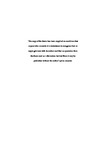The biogeography and conservation status of the rocky plateaus of the northern Western Ghats, India.
| dc.contributor.supervisor | Knight, Mairi | |
| dc.contributor.author | Thorpe, Christopher John | |
| dc.contributor.other | School of Biological and Marine Sciences | en_US |
| dc.date.accessioned | 2018-11-19T17:23:18Z | |
| dc.date.issued | 2018 | |
| dc.date.issued | 2018 | |
| dc.identifier | 10149746 | en_US |
| dc.identifier.uri | http://hdl.handle.net/10026.1/12826 | |
| dc.description.abstract |
Rocky plateaus are globally threatened ecosystems and the lateritic plateaus in northern section of the Indian Western Ghats/Sri Lanka Biodiversity Hotspot (NWG) are notable landscape features. The NWG are geologically distinct from and biologically isolated from the other two sections of the Western Ghats. The NWG is known to possess elevated levels of endemic flora their biotic relationships remain poorly understood. We present here the first quantitative multi-taxa comparative study of plateau fauna in the northern Western Ghats. Ants, water beetles and amphibians were selected for the comparison as they use different ecological resources from each other and at various times of year therefore may provide a wider representation of plateau usage. Distribution and endemism were expected to reflect distribution and isolation by plateau and inter-plateau environment related to elevational, latitudinal, climatic and land-use clines. The study explored patterns of amphibian, water beetle, ant and fungal distribution and sampling seasonal pools and terrestrial surfaces of 13 representative plateaus in western Maharashtra, with sites ranging from 67-1179 m and across 2° of (sub) tropical latitude. Distribution of all taxonomic groups was spatially non-random at all levels of organisation and across all spatial scales. At the macroscale assemblages differed significantly with climate related to elevation, latitude but at a local scale land-use and microhabitat availably had an impact. Ants displayed a large seasonal assemblage variation, responding to seed availability. Water beetles the ants (combined survey data) were the best surrogates for all taxa data with amphibians the weakest representatives. Infection by the fungal pathogen, Batrachochytrium dendrobatidis, was extensive but less intense below the escarpment. We report the first records of infection in 13 endangered and data deficient amphibian species in the Western Ghats. The plateaus of western Maharashtra have recently been recognised as fragile and threatened ecosystems most still lack adequate statutory protection. In the absence of peer reviewed comparative data, the importance of individual sites is difficult to demonstrate hampering evidence-based conservation decisions. | en_US |
| dc.description.sponsorship | The Royal geographical Society with IBG | en_US |
| dc.description.sponsorship | The Erasmus Darwin Barlow Expedition Fund, Zoological Society of London | en_US |
| dc.language.iso | en | |
| dc.publisher | University of Plymouth | |
| dc.rights | CC0 1.0 Universal | * |
| dc.rights.uri | http://creativecommons.org/publicdomain/zero/1.0/ | * |
| dc.subject | Biogeography | |
| dc.subject | Rocky Plateaus | |
| dc.subject | Ferricretes | |
| dc.subject | Laterite | |
| dc.subject | Amphibians | |
| dc.subject | Water Beetles | |
| dc.subject | Ants | |
| dc.subject | Rock Pools | |
| dc.subject | Sub-Tropic | |
| dc.subject | Terrestrial Islands | |
| dc.subject | India, Western Ghats | en_US |
| dc.subject.classification | PhD | en_US |
| dc.title | The biogeography and conservation status of the rocky plateaus of the northern Western Ghats, India. | en_US |
| dc.type | Thesis | |
| plymouth.version | publishable | en_US |
| dc.identifier.doi | http://dx.doi.org/10.24382/603 | |
| dc.rights.embargodate | 2019-11-19T17:23:18Z | |
| dc.rights.embargoperiod | 12 months | en_US |
| dc.type.qualification | Doctorate | en_US |
| rioxxterms.version | NA | |
| plymouth.orcid.id | 0000-0002-1045-8408 | en_US |
Files in this item
This item appears in the following Collection(s)
-
01 Research Theses Main Collection
Research Theses Main



